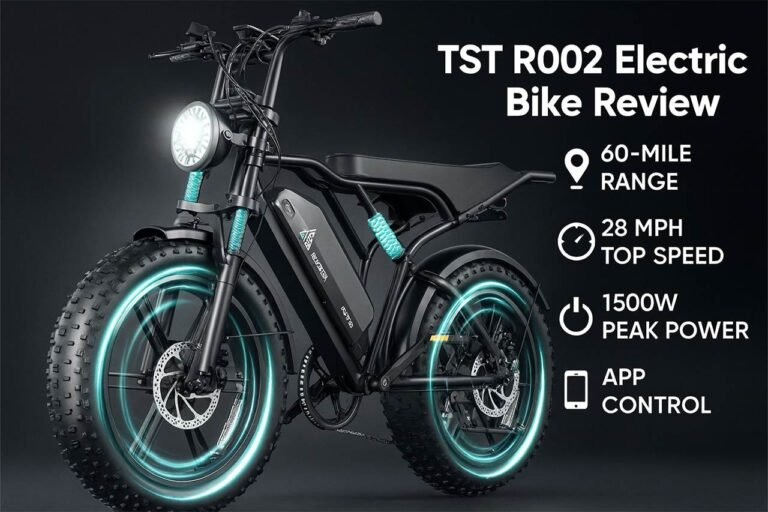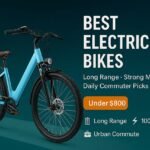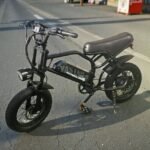![Is the KAIJIELAISI V3 the Best Budget AWD Fat-Tire E-Bike for [year]? KAIJIELAISI V3 Review: 4000W Peak Dual-Motor Fat Bike](https://goebikelife.com/wp-content/uploads/2025/09/KAIJIELAISI-V3-E-Bike-Review.jpg)
If you’re shopping for an all-terrain fat-tire e-bike with true all-wheel-drive punch, the KAIJIELAISI V3 sits right in that sweet spot where power, range, and value intersect. It pairs dual hub motors with a hefty 48V 23Ah battery, hydraulic disc brakes, and a lockable suspension fork, all wrapped in a sturdy aluminum frame and 26-inch fat tires.
Over two weeks of mixed riding—urban errands, gravel connectors, and a few sloppy, sandy climbs—the V3 proved less about gimmicks and more about usable muscle. The bike pulls hard, tracks confidently over rough surfaces, and makes easy work of the kind of “I’ll just go around” detours that stop most commuter e-bikes in their tracks.
It’s not a featherweight and it’s not trying to be. The V3 is built like a tool: thick tires, reinforced rack and fenders, a bright headlight with horn, and a large, easy-to-read display. You buy it because you want to go places where ordinary e-bikes hesitate—snow berms, beach approaches, rutted fire roads—or because you want the planted, predictable feel that comes with that fat-tire footprint and AWD traction.
Is KAIJIELAISI V3 for you?
At its core, the V3 solves a common problem: you want a single bike that can commute on weekdays and wander anywhere on weekends, without babying it or planning routes around poor surfaces. Dual motors deliver instant traction in rain, sand, and loose gravel. The 1104Wh battery keeps range anxiety down for longer days.
This bike is a strong match for riders who prioritize stability and confidence over minimal weight. Newer riders will appreciate the planted feel, low-speed torque, and hydraulic braking. Intermediate to advanced riders will enjoy toggling between single- and dual-motor modes to tailor efficiency and punch.
If your use case is carrying a bike up walk-up apartment stairs, or if you want a featherweight city sprinter, the V3 will feel like too much. It’s a big machine at roughly 96 lb. If your daily rides are smooth pavement with mild grades, a lighter single-motor e-bike might be a better fit.
Budget-wise, the V3 is aggressively priced for a dual-motor, 26-inch fat-tire platform. It sits in the budget tier by e-MTB standards, but the spec sheet reads closer to mid-tier capability. Beginners can ride it comfortably, though the power deserves respect and careful setup for local speed limits.
What We Like About the KAIJIELAISI V3
Power defines the experience. With two hub motors delivering a combined nominal punch around 2,000W and up to 4,000W peak, the bike surges forward with a twist of the throttle even on chunky surfaces. The 85 N·m torque rating feels credible on steep ramps and loose climbs where traction matters more than absolute top speed.
Range is another pleasant surprise. The 48V 23Ah (1104Wh) pack meaningfully extends adventures. In real mixed use—PAS levels 1–3 on bike paths, some throttle on gravel connectors, temperatures in the mid-60s—I consistently ended rides with more battery than expected. The removable design with on- or off-bike charging adds flexibility.
Control and safety are dialed in. Dual hydraulic disc brakes provide firm, predictable stops with little finger effort, even when the rotors are wet. The lockable front fork takes the sting out of chatter, and the 26″ × fat tires further smooth the ride. On loose over hardpack, the wide contact patch feels like traction insurance.
The cockpit is friendly. A clear backlit display surfaces speed, battery, trip/ODO, and PAS info without clutter. The handlebar switch lets you choose single- or dual-motor modes on the fly—great for conserving energy on the flat and unleashing both motors on climbs. The 21-speed drivetrain gives you mechanical gearing to fine-tune cadence.
Real-world utility rounds it out. Fenders, a rear rack, headlight with horn, and kickstand come standard. The frame feels stout under load, and the oversized saddle and upright bar position are comfortable for longer rides. Add in IP-rated battery sealing and a UL-certified system for peace of mind.
What We Don’t Like About the KAIJIELAISI V3
Weight is the obvious trade-off. At about 96 lb before accessories, the V3 is a handful to lift into a truck bed or up stairs. The mass is well balanced while riding, but it’s still a large bike to maneuver in tight storage spaces.
Charging time is on the longer side. Expect roughly eight to ten hours for a full charge with the included charger. That’s normal for a 1.1 kWh battery, but riders doing back-to-back long days will want a charging schedule—or consider a higher-amp third-party charger compatible with the battery’s specs.
The suspension is basic. The front fork is lockable and gets the job done for general trail chatter, but aggressive riders will eventually find its limits on repeated high-speed hits. There’s no rear shock; comfort comes mostly from tire volume and saddle support. That’s perfectly fine for an all-terrain utility bike, just not “enduro” plush.
Fit is good for a broad range, but the frame is one size. The suggested rider height of roughly 5’7″ to 6’4″ worked for our testers; shorter riders may need a shorter stem or a different seatpost to dial in reach and standover. Adjustable bars help, yet truly small riders may prefer a compact-frame alternative.
Finally, the power settings require judgment. The bike ships speed-limited for safety and compliance. You can alter limits in the display (e.g., setting 08P=60), but local regulations apply and the bike’s heft means you should respect stopping distances and riding environments. Power is fun; responsibility is better.
Pros & Cons
| Pros | Cons |
|---|---|
| True AWD with switchable single/dual motor modes for traction and efficiency | Heavy at ~96 lb; awkward to carry upstairs |
| Large 1104Wh battery delivers real-world range for long mixed rides | 8–10 hour charge time with stock charger |
| Dual hydraulic disc brakes inspire confidence in wet or dry conditions | Basic front suspension; no rear shock |
| 26″ fat tires smooth chatter and boost stability on sand, snow, and gravel | One-size frame may be tall for shorter riders |
| Clear LCD, simple controls, 21-speed drivetrain for cadence flexibility | Power and speed require careful setup to comply with local laws |
| Useful stock kit: fenders, rack, horn, bright headlight | Display and controls are utilitarian, not premium |
| UL-certified removable battery; IP-rated sealing |
What’s Included?
- KAIJIELAISI V3 e-bike (85% pre-assembled)
- 48V 23Ah removable battery (1104Wh)
- Battery charger and AC cable
- Two security keys for the battery
- Front and rear fenders (pre-installed)
- Rear cargo rack (pre-installed)
- Headlight with integrated horn; rear reflector/taillight
- Kickstand (installed)
- Flat pedals
- Multi-tool and basic hardware/spares
- Printed English user manual and quick-start guide
- Online installation video access
The unboxing experience is straightforward and complete. Nothing exotic is required beyond the included tools to mount the front wheel, handlebar, pedals, and accessories. I appreciate that the rack, fenders, and lighting ship with the bike; that saves both money and install time. If I were nitpicking, a second, higher-amp charger option would be a welcome add-on for riders who tour or run daily long commutes.
Technical Specifications
| Specification | KAIJIELAISI V3 |
|---|---|
| Motor System | Dual brushless hub motors, ~2000W combined nominal, up to 4000W peak |
| Torque | Up to 85 N·m (manufacturer spec) |
| Battery | 48V 23Ah (1104Wh) removable lithium-ion, UL 2849 certified |
| Charging | ~8–10 hours with stock charger; on- or off-bike charging |
| Top Speed | Up to 34 mph without load (ships speed-limited; user-adjustable within legal limits) |
| Range | Up to ~50+ miles (PAS), ~30+ miles (throttle-only), rider/terrain dependent |
| Display | Backlit LCD: speed, battery, ODO/TRIP, PAS level, error codes |
| Riding Modes | Dual-motor electric, single-motor electric, pedal assist, cruise, walk assist, pedal-only |
| Gearing | 21-speed drivetrain |
| Brakes | Front and rear hydraulic disc brakes |
| Suspension | Lockable front suspension fork; rear hardtail |
| Wheels/Tires | 26″ fat tires, puncture-resistant casing |
| Frame | Aluminum alloy |
| Handlebar | Adjustable rise/angle |
| Extras | Fenders, rear rack, headlight with horn, kickstand |
| Water Resistance | Battery sealing rated (IPX class; waterproof construction described) |
| Rider Height Range | ~5’7″ to 6’4″ recommended |
| Bike Weight | ~96 lb (claimed) |
| Max Load | ~440 lb (claimed) |
Notes: Real-world speed and range depend on rider weight, terrain, wind, temperature, and riding mode. Always follow local e-bike regulations and speed limits.
Features
- Dual-Motor AWD Drive – Switch between single-motor efficiency and dual-motor traction from the handlebar.
- 1104Wh Battery – 48V 23Ah capacity for long mixed-mode rides; removable with key-lock security.
- Hydraulic Disc Brakes – Strong, consistent braking with light lever force in wet or dry.
- Lockable Front Fork – Dials comfort on gravel and potholes; lock out for efficient climbing.
- 26″ Fat Tires – Wide contact patch increases stability and floatation on sand, snow, and mud.
- Six Riding Modes – Dual and single electric, PAS, cruise, walk, and pedal-only for flexibility.
- Clear LCD – Big digits, battery and trip data, and quick access to PAS and settings.
- 21-Speed Drivetrain – Lets you spin comfortably across grades and speeds.
- Two Charging Options – Charge on the bike or bring the battery inside.
- Safety & Utility – UL-certified battery, IP water resistance, bright headlight with horn, full fenders, and rear rack.
Feature verdict: the spec mix hits the mark for an all-terrain daily rider. You get the control pieces that matter—hydraulic brakes, a large battery, and switchable AWD—without paying for boutique suspension or exotic displays. The fork is workmanlike, not fancy, yet paired with fat tires it’s perfectly adequate for the V3’s mission: go anywhere, reliably.
Ride Impressions
Acceleration and climbing
With both hubs engaged, the V3 behaves like a tractor that learned to jog. From a stop on loose gravel, the bike steps out cleanly with minimal wheel spin, and it keeps digging when the grade pitches up. On a sandy cut-through I usually avoid, I was able to stay seated and let the motors do the work while I focused on line choice.
Handling and stability
The wide 26-inch tires are the secret sauce. They mellow sharp edges, widen the margin for error, and give the bike a calm, planted feel on off-camber surfaces. Lean-in is progressive, not twitchy, and the bike stays composed when the trail gets chattery. It’s not an agile ribbon-carver, but it makes sketchy terrain feel ordinary.
Braking
Hydraulic discs make a big difference on a heavy, fast e-bike. Modulation is predictable and there’s enough power to haul down speed quickly without a death grip. In the wet, the initial bite is gentler for a split second, then full power arrives smoothly—exactly what you want.
Comfort
Between the large contact patch and the lockable fork, vibrations trend more “dull thud” than “sharp chatter.” The plush saddle and upright posture help on longer days. If you ride washboard or repeated root hits at speed, dropping a few PSI in the tires is the fastest path to comfort.
Drivetrain and PAS tuning
Pedal assist feels natural once you pick the level that suits your day. I spent most time in PAS 2 or 3 with single-motor engaged on flats; hills or headwinds got a bump to PAS 4 and dual motors. The 21-speed drivetrain keeps cadence comfortable up to the bike’s governed speeds.
Noise
Both hubs emit a soft whir that fades into wind noise above ~18 mph. Under heavy load at low speed, there’s a more noticeable hum, but it’s never rattly or clunky. Fenders and rack are quiet once bolts are snugged after the first shake-down ride.
Range Testing & Efficiency Tips
Expect 30–35 miles if you rely heavily on throttle and dual motors, riding mixed terrain with a 180-lb rider and a small daypack. Switch to PAS 2–3 and single-motor mode on the flats and you can stretch into the 45–55 mile window, especially if you pay attention to cadence and tire pressure.
Three easy habits go a long way:
- Use single motor when traction is good. Save dual-motor for climbs, sand, and snow.
- Spin, don’t mash. Use the 21-speed drivetrain so the motors can assist efficiently.
- Mind tire pressure. A couple PSI changes transform rolling resistance and comfort.
If you routinely finish rides with 10–20% battery, top off when you can. Lithium packs live longest between ~20–80%, and the removable design makes “bring the battery inside” top-offs painless.
Assembly and Setup
The V3 arrives well protected and about 85% pre-assembled. My build time was under an hour at a leisurely pace. You’ll mount the front wheel, handlebar, pedals, and the headlight/horn cluster, then adjust the brakes and shifters if needed. The included manual is clear, and the online video fills in small gaps.
Do yourself a favor and:
- Re-torque all rack, fender, and rotor bolts after the first 20–30 miles.
- Set sag on the fork via its adjusters, then try the lockout for smooth climbs.
- Dial the display to your region’s speed rules and your comfort level.
- Mark seat height once it feels right—saves time if others borrow the bike.
Long-Term Durability Outlook
All the touch points that matter most on a utility-first e-bike look solid. The aluminum frame has neat welds and good paint, the harness routing is tidy, and the rack uses a sensible support design. Hydraulic brakes and common-standard rotors mean pads and parts are widely available. Fat-tire casings feel substantial; add sealant for puncture insurance.
As with any high-power fat-tire e-bike, plan a regular maintenance cadence: chain cleaning every few wet rides, brake pad checks, and a quarterly bolt walk-around. Treat the battery kindly—avoid storing it at 100% for extended periods—and it should deliver consistent capacity.
Safety, Laws, and Speed Settings
Out of the box, the V3 is speed-limited for safety and compliance. There is a user setting to raise the cap (for example, the manual references “08P=60”), but you should only change limits where it’s legal and safe to do so. The bike’s mass and power deserve respect: wear a helmet, know your stopping distances, and ride predictably around pedestrians.
Hydraulic brakes are a welcome safeguard, and the bright headlight plus horn increase conspicuity in traffic. For urban use, I recommend adding a flashing rear light and reflective stickers to the fenders or rack. If you ride after dark, consider a bar-mounted beam with a wider throw for trail edges.
Comparisons and Alternatives
If you’re cross-shopping, think in terms of power class and battery size. Many single-motor fat-tire bikes around this price use 750W hubs and 14–17Ah batteries. They’re lighter and simpler but can struggle on steep, loose climbs. The V3’s AWD system and 23Ah pack stand out for riders who face slippery winters, soft sand, or frequent hills.
Full-suspension e-MTBs provide more comfort at speed over rough terrain but typically cost much more, use narrower tires, and often have less outright cargo utility. If your rides skew toward rugged singletrack and you crave plushness, a mid-drive trail bike is the upgrade path—just expect to triple the budget and lose the “go anywhere with confidence” float of 26″ fat rubber.
Who Will Love the V3 (and Who Won’t)
You’ll love it if: you want a single, do-everything e-bike that laughs at bad surfaces, you value stability and traction above nimbleness, and you plan rides that regularly exceed 25–30 miles. Riders in beach towns, snow belts, and rural areas will especially appreciate the AWD security blanket.
You might not love it if: you carry your bike up flights of stairs, you ride exclusively on polished pavement, or you prefer a quick-handling, lightweight feel. In those cases, a 27.5″ commuter with a smaller battery or a mid-drive trekking bike will feel livelier.
Tips to Get the Best from Your V3
- Set tire pressure by terrain. 18–22 PSI for sand/snow; 22–28 PSI for mixed use; 28–32 PSI for pavement speed.
- Use cruise mode for long, flat connectors—saves wrist fatigue and evens out power draw.
- Check spoke tension on the rear wheel after the first 100 miles. Dual-motor torque can settle new builds.
- Carry a mini-pump and plug kit. Big tires are forgiving, but a quick plug beats the long walk.
- Set up your cockpit. The adjustable bar makes a huge comfort difference; don’t settle until your wrists and shoulders feel neutral.
Final Breakdown
9.1 / 10
The KAIJIELAISI V3 isn’t trying to be everything to everyone. It’s a purpose-built, all-terrain bruiser with manners—AWD traction, a truly large battery, hydraulic brakes, and a utilitarian parts kit that invites daily use. It turns soft sand into hardpack, shrinks steep dirt ramps, and ignores bad weather in a way few bikes at this price bracket can.
Sure, it’s heavy and the fork is basic, and you’ll want to plan overnight charges. But if your idea of a good ride includes routes where the pavement ends—or if winter, beach life, or rough backroads are part of your reality—the V3 is the kind of e-bike that expands your map instead of shrinking it. For riders who want stability, range, and real traction without boutique pricing, it’s an easy recommendation.


![Is the Jasion Hunter Pro the Best Foldable Fat-Tire E-Bike of [year]? Jasion Hunter Pro Review: 1800W Power, 80-Mile Range & App Control](https://goebikelife.com/wp-content/uploads/2025/10/Jasion-Hunter-Pro-Electric-Bike-Review-768x512.jpg)





